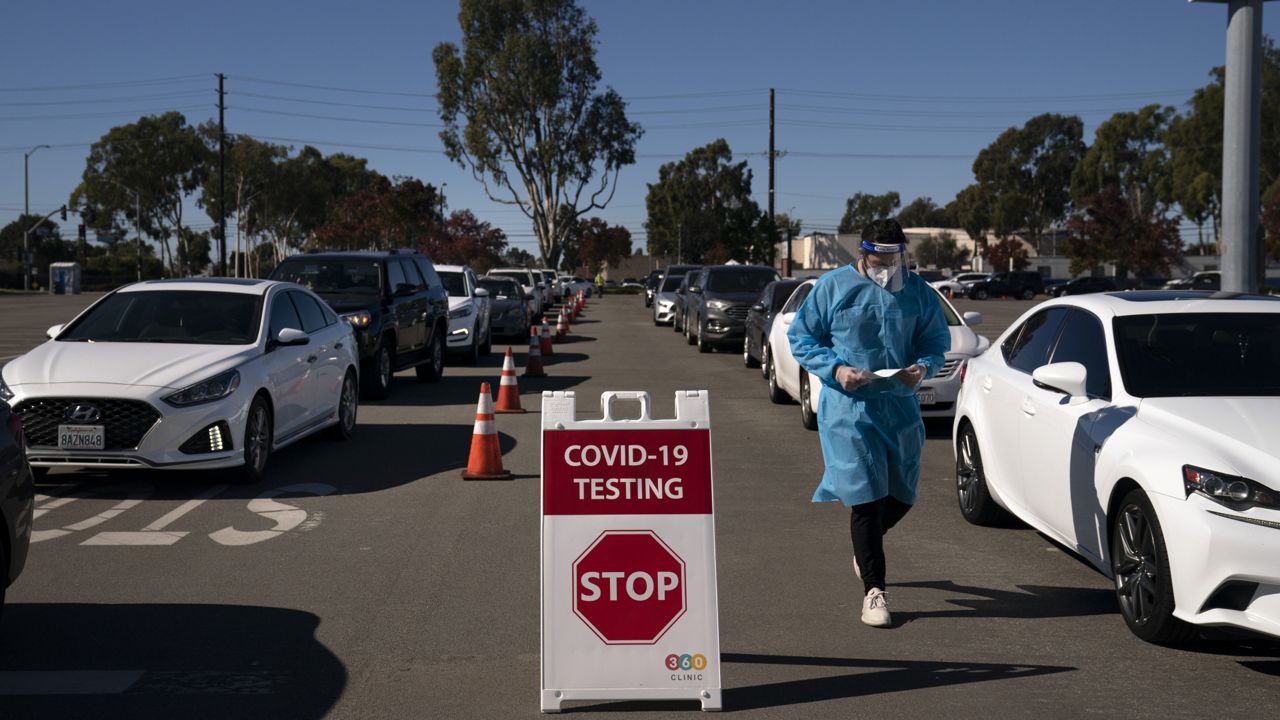SANTA ANA, Calif. (CNS) — Orange County's COVID-19 case and hospitalization rates continued to climb Tuesday to numbers approaching the summer wave.
What You Need To Know
- The number of county residents hospitalized with the virus jumped from 605 on Monday to 648 on Tuesday
- The change in the three-day average of hospitalized patients went from 17% to 20.2%
- The adjusted daily case rate per 100,000 rose from 18.7 on Monday to 22.2 on Tuesday
- The number of tests conducted in the county stands at 1,469,434, including 17,236 reported Tuesday
The county reported 790 newly diagnosed coronavirus cases, bringing the cumulative total to 79,343, but the death toll remained unchanged at 1,577. No new fatalities have been reported since Sunday; the county logged 26 coronavirus-related fatalities from Nov. 22 through Saturday.
The number of county residents hospitalized with the virus jumped from 605 on Monday to 648 on Tuesday, with the number of patients in intensive care units increasing from 146 to 158, according to the Orange County Health Care Agency.
The change in the three-day average of hospitalized patients went from 17% to 20.2%. The last time hospitalization rates were this high was the end of July, and the last time ICU rates were this high was around Aug. 10.
The county has 23% of its intensive care unit beds and 61% of its ventilators available.
The state's tiered monitoring system metrics were updated again Tuesday. The adjusted daily case rate per 100,000 rose from 18.7 on Monday to 22.2 on Tuesday, with the positivity rate going up from 7.6% to 8.8%.
The county's Health Equity Quartile Positivity Rate, which measures the cases in highly affected, needier parts of the county, now stands at 13%, nearly three times higher than it was last reported Nov. 10.
Now all of the county's metrics fall within the state's most- restrictive purple tier.
The county's unadjusted case rate per 100,000, which doesn't take into account testing rates and other factors, stands at 29.8. That is "middle of the pack" in Southern California with San Bernardino at 46.1 and Riverside at 28.5, county CEO Frank Kim said.
"I don't think anyone is proud of their numbers," Kim said. "Our ICU numbers haven't reached the peak we saw in the summer, but I'm certainly concerned" about the trend.
Orange County Supervisor Lisa Bartlett, who is president of the California State Association of Counties, said: "There's plenty of space for ICU expansion and equipment like ventilators and (personal protective equipment), but there's a potential major shortage of hospital staffing" for ICU beds, which require a higher-degree of care skills and experience.
Orange County "has been in a bit of a bubble ... where we have significant hospital bed capacity that can be staffed and we've got ventilators and PPE," Bartlett said. "But other counties may not be in the same situation we're in, and that concerns me."
Orange County's hospitals, as they did this summer, will have to take on patients from other more stressed hospital systems in the state, Bartlett said.
The mounting numbers over the holiday weekend seem to confirm officials' fears of a Thanksgiving-fueled surge. The impact the holiday and Black Friday shopping likely won't be seen for another week, Kim said.
He said he was encouraged to see the county's testing rate per 100,000 at 411.2. Officials hope that testing will encourage the afflicted to quarantine and contact others about exposure, encouraging them to socially distance.
"The important thing is we have testing capacity to meet the demand, so we continue to add additional capacity at our super sites," Kim said.
The county has also received about 500 some take-home testing kits that were disseminated starting last week, Kim said. About 50 of them came back positive, in keeping with the general positivity rate, Kim said. The county expects another shipment of about 5,000 of the take-home tests soon, he said.
Officials recommend waiting at least two days after traveling or attending an event or gathering to get tested because the infection might not be detected right away.
The county is expecting to receive its first shipment of vaccines by mid-December, Kim said. Larger hospital systems will get them directly, but the county will receive vaccines to hand out to individual, stand-alone hospitals, Kim said.
County officials are concerned about whether enough people will get shots to achieve herd immunity, so they sent out a survey and received about 20,000 responses that they hope to use to guide a public awareness campaign, Kim said.
Kim was also encouraged about news of a bipartisan group of senators floating an economic stimulus bill. Counties and cities need the money to continue financing widespread testing, he said.
"I'm hoping that's a sign of good news that Congress will engage and do the right thing and return some of those tax dollars back into the community so we can continue our testing programs and other things," Kim said.
Without stimulus funding, the county would have to cut back on testing and core public services fueled by the pandemic, Kim said.
"Ultimately, when you have a loss of revenue you have a growing demand for services with a matching-grant requirement — and you can't say no because it's an entitlement program," Kim said. "I have to squeeze somewhere else in the county and it's going to push up against public safety and public health unless I get stimulus."
Frontline health care workers will be among the first to receive vaccinations, along with people with underlying health conditions that make them especially vulnerable to the disease.
The number of tests conducted in the county stands at 1,469,434, including 17,236 reported Tuesday. There have been 60,186 documented recoveries.



